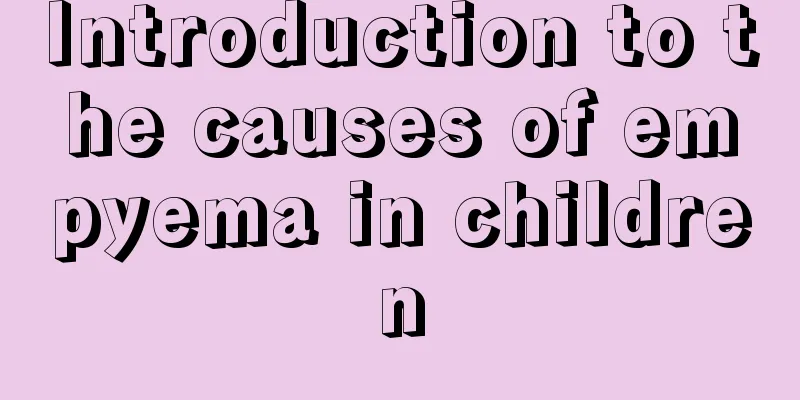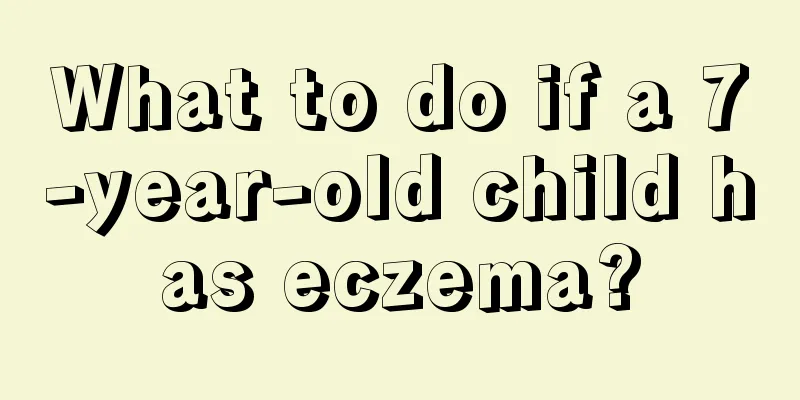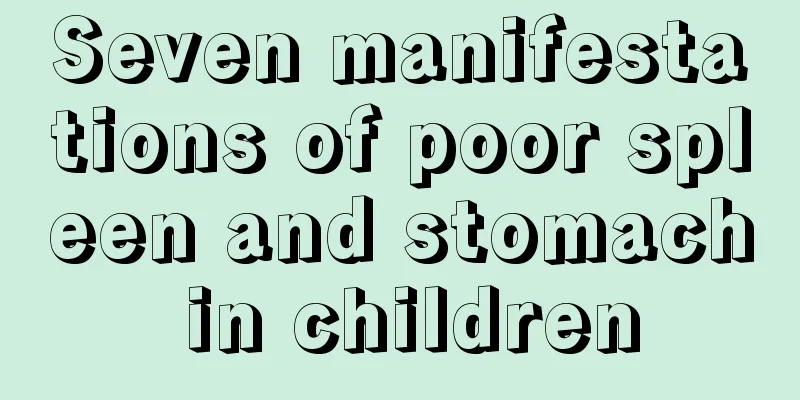Introduction to the causes of empyema in children

|
Empyema in children is one of the more common chest diseases. Nowadays, there are many causes of empyema in children, and it is more common in infants and young children. So, what are the specific causes of empyema in children? How should we treat pyothorax in children? Let’s learn more about it through the following article. (1) The main cause of the disease is that the pathogens in the infection focus in the lungs directly invade the pleura or lymphatic tissue. The majority of cases develop from pneumonia. It is also not uncommon for it to occur in the setting of lung abscess and bronchiectasis. In addition, direct contamination from operations such as mediastinitis, subphrenic abscess, chest trauma, surgery, or puncture is also possible, which may also cause sepsis. Staphylococcus aureus is the main cause of empyema. Streptococcal or pneumococcal pneumonia complicated by empyema is now rare in my country. Mixed Gram-negative bacterial infections can also be seen. Causes and treatment of empyema in children (II) Pathogenesis: After the pathogenic bacteria invade the pleura, the parietal and visceral layers rapidly undergo extensive inflammatory changes, first with serous exudation, followed by the formation of fibrin and inflammatory cell deposition. Due to the large-scale bacterial reproduction, the exudate becomes turbid and viscous or thin pus. The pus of pneumococcus and Staphylococcus aureus is thick and contains a large amount of cellulose, which can easily cause extensive adhesion. Streptococcal pus is thin and produces less adhesion. Pleural empyema usually occurs on one side, most often in the posterior part of the lower part, but can also be seen between the two lobes, or between the lower lobe and the diaphragm. The severity of the compression symptoms varies with the location and amount of pus. If a large amount of pus fills the affected chest cavity and cannot be discharged in time, lung collapse may occur, causing the mediastinum and heart to shift, and damaging heart and lung function. Due to unilocular or multilocular encapsulated empyema, diaphragmatic movement and lung function are affected. If pus penetrates the lung tissue, a bronchopleural fistula may form. If pus penetrates the chest wall, a self-rupturing empyema may form. When severe lung collapse cannot recover for a long time, the chest cavity may become deformed. Symptoms of empyema in children Empyema mostly occurs in the early stages of pneumonia, and its initial symptoms are the symptoms of pneumonia. In some children, even though the treatment for pneumonia is not enough, the symptoms of pneumonia improve for a while, but then symptoms of empyema appear. Most of the sick children have persistent high fever. When an infant develops empyema, he or she will only show moderate worsening of dyspnea; older children will develop more severe symptoms of poisoning and severe dyspnea, and cough and chest pain will also be more obvious. When tension pyopneumothorax occurs, there is a sudden onset of shortness of breath, flaring of the nasal wing, cyanosis, irritability, persistent cough, and even respiratory arrest. The white blood cell count generally increases to (15-40)×109/L (15,000-40,000/mm3), with toxic particles. Children with empyema have severe poisoning symptoms. Chronic consumption causes them to suffer from malnutrition and anemia at an early age, and they also have poor spirits and indifference to the environment. According to the pathophysiological changes of empyema, there are generally the following two situations: 1. Difficulty breathing: There are three common reasons: (1) Pleural shock reaction: It is caused by the inability of the pleura to adapt to sudden stimulation. You need to stay calm and rest, and puncture decompression is not recommended. (2) Lung compression: The lungs are severely compressed and the mediastinum is displaced. Drainage is required for decompression. (3) Toxic shock: The patient's breathing is smooth and the respiratory volume is not reduced, but he still suffers from hypoxia, which is caused by circulatory failure. Urgently need blood transfusion, infusion, anti-infection and cardiotonic treatment. 2. Persistent high fever: The tension of pleural effusion is high, a large amount of toxins are absorbed, the poisoning is obvious, and the local high pressure can easily spread the infection, so early drainage is recommended. There was no pus accumulation, no tension, and the lesions were mainly infiltrative. Surgical drainage did not help reduce the fever. The clinical manifestations of neonatal empyema are even less characteristic. When there is dyspnea or perioral cyanosis, the chest should be carefully examined. The affected side may show a full chest, widened intercostal space, weakened respiratory movement, and displacement of the trachea and heart to the healthy side. Dull or solid sounds during percussion, decreased vocal fremitus, and decreased or completely absent breath sounds indicate pleural effusion, which requires further X-ray examination. Newborns have a poor ability to localize inflammation and are prone to sepsis, chest wall infection, and even respiratory failure. According to severe poisoning symptoms. Difficulty breathing, tracheal and cardiac dullness boundaries shifted to the opposite side, large areas of dullness were heard on the affected side, and breath sounds were significantly reduced. It can be roughly diagnosed as empyema. A chest X-ray can confirm the presence of pleural effusion. The X-ray sign of effusion is a large area of uniform dark shadows on the chest, with the lung patterns mostly obscured and the mediastinum clearly pushed to the opposite side. In the standing position, the costophrenic angle may disappear or the diaphragm movement may be restricted. Sometimes an arc-shaped shadow may be seen in the abscess in the lower part of the chest cavity. An air-fluid level may be seen in cases of pyopneumothorax. A flake-like shadow with clear edges may be a cystic empyema. When there is interlobar empyema, the lateral X-ray film shows interlobar fusiform shadows. When performing X-ray examination of empyema, the location of pus accumulation should also be identified to provide a reference for treatment. When performing chest fluoroscopy in a standing position, the body is turned from the posteroanterior position to the lateral position, from which it can be determined whether the pus is accumulated in the upper or lower part of the chest cavity, in the front, back, inside or side. The diagnosis of empyema must be based on the extraction of pus by thoracentesis. Generally, the properties of pus are related to the pathogen. The type of pathogen can be preliminarily inferred from the appearance of the pus. If caused by Staphylococcus aureus, the pus is extremely viscous and yellow or yellow-green in color. Yellow-green pus is mostly caused by pneumococcus; those caused by staphylococci are also thicker and yellow; those caused by streptococci are thin, light yellow, and rice-soup-like; green and smelly pus is often caused by anaerobic bacteria. Pleural pus should be cultured and tested for drug sensitivity to provide a basis for the selection of antibiotics. Diagnosis of empyema in children Examination and testing of empyema in children 1. Blood examination: Routine blood test shows leukocytosis, which can reach (15-40)×109/L, neutrophil granulocytes reaching more than 80%, toxic granules can be seen in leukocytes, and nuclear left shift may occur. White blood cell alkaline phosphatase and serum C-reactive protein were elevated. 2. Pathogen examination: To confirm the diagnosis of empyema, thoracentesis must be performed to draw out pus. Smear microscopy, bacterial culture and antibiotic sensitivity tests are also performed, and effective antibiotics are selected for treatment. 1. X-ray examination: The manifestations vary depending on the amount and location of pleural effusion. 2. Ultrasonic examination: The reflected waves of the effusion can be seen, which can clearly determine the scope of the effusion and make accurate positioning, which helps to determine the puncture site. Differential diagnosis of empyema in children Empyema must often be differentiated from the following diseases. 1. In case of extensive lung collapse or pneumonia empyema, the intercostal space is dilated and the trachea is deviated to the opposite side. In case of lung collapse, the intercostal space is narrowed and the trachea is deviated to the affected side, and there is no pus during puncture. 2. Huge bullae and lung abscesses, especially in newborns, may cause complete compression of one lung, making it difficult to identify. However, early treatment does not make much difference in principle. When there are compression symptoms, after puncture decompression, the diagnosis can be made based on the distribution of lung tissue expansion. In empyema, the lung tissue is concentrated and compressed at the hilum, while in bullae, the lung tissue is expanded at the periphery and breath sounds are present. 3. If the diaphragmatic hernia is not discovered and is complicated by pneumonia or upper respiratory tract infection, the chest X-ray may show multiple air-fluid shadows (intestinal herniation) or large fluid surface (gastric herniation) which may be mistaken for pyopneumothorax. The puncture will reveal turbid fluid, mucus, and fecal juice, which can confirm the diagnosis. 4. Huge subphrenic abscess also produces reactive effusion in the chest cavity, but rarely has lung tissue lesions. There is no negative pressure after puncture and drainage, or after negative pressure air intake, X-rays show that the abscess cavity is below the diaphragm. Ultrasound can help locate the abscess. 5. Pulmonary hydatid disease or hepatic hydatid disease penetrates into the chest cavity and may cause special types of pleurisy or hydropneumothorax. The diagnosis can be confirmed based on the epidemiological history of hydatid disease and specific tests. 6. Connective tissue disease combined with pleurisy sometimes resembles sepsis with empyema. Pleural effusion looks like exudate or thin pus, and the white blood cells are mainly polymorphonuclear neutrophils. Pleural fluid smear and culture were sterile. Treatment with corticosteroids is rapidly absorbed. Complications of empyema in children The most common complications of empyema are bronchopleural fistula and tension pneumothorax. Local spread may cause pericarditis, penetration of the diaphragm may cause peritonitis, and rupture to the chest wall may cause rib osteomyelitis. Septic complications include purulent meningitis, arthritis, and osteomyelitis. Chronic empyema may be combined with malnutrition, anemia, chronic dehydration and amyloidosis. Prevention and treatment of empyema in children Since most cases of purulent pleurisy are secondary to bacterial pneumonia, antibiotics should be used rationally in the early stages of pneumonia to prevent the development of purulent pleurisy. (I) Treatment of empyema requires positive results in the following three aspects to be effective: ① discharge of pus and relief of chest compression; ② control of infection; ③ improvement of general condition. 1. General treatment principles (1) Antibiotics: For children with symptoms mainly of high fever and poisoning, but without obvious compression symptoms, large amounts of systemic antibacterial drugs or traditional Chinese medicine should be used for treatment. (2) Early drainage: When there is a lot of pus and the main symptom is compression, it is advisable to drain the pus early during the infiltration and diffusion stage, preferably within 3 days of onset, so that the lungs can expand quickly and the pus cavity can close. (3) Closed drainage: Patients with empyema that lasts for more than one week, with heavy secretions and rapidly growing pus should undergo closed drainage. Generally, drainage for two weeks is sufficient. If the secretion is small, intermittent thoracentesis can be performed every other day until the pus is reduced and only gas remains. No further puncture is necessary. (4) Chronic empyema: When the main symptom is pleural effusion without tension, no local treatment is required and the patient can wait for natural absorption. If the fever does not subside, the pus does not decrease, or it increases rapidly after drainage, it is necessary to drain the pus to allow air to enter and take a photograph. After understanding the situation of the pus cavity, it can be decided to drain or perform a thoracotomy to remove foreign bodies (necrotic tissue, pus masses, etc.). (5) Bronchopleural fistula: The patient usually coughs and produces a lot of sputum. After methylene blue is injected into the chest cavity, the sputum turns blue. Open drainage is performed first, and pleuropulmonary resection is performed after the general condition improves. (6) Chest deformity: Most children can recover on their own within a few years. Currently, pleural decortication is rarely required except for tuberculous empyema. 2. Conditions for discontinuation of medication for acute empyema (1) Body temperature is stable and normal. (2) White blood cell count is basically normal. (3) Good mental and physical appetite. (4) There is no local pus or the daily drainage volume is less than 20 ml. If the above 4 conditions are met, the patient can stop taking medication and be discharged from the hospital one week later. Those who are deficient in any of the above conditions can be discharged from the hospital and stop taking medication for observation. If two of the above conditions are deficient, treatment should be continued. 3. Piercing therapy (1) Principles of puncture therapy: ① Diagnostic puncture (bacterial smear, culture, and observation of the solid content and properties of the puncture fluid after standing for 24 hours). ②Daily puncture and drainage of pus can be performed within 3 days to expand the lungs. ③Whenever there is an increase in pus or tension, puncture should be performed before drainage. (2) Puncture technique: ① Positioning: A. Trial puncture: After the anesthesia is injected, a small local anesthesia needle must be used to puncture the area for trial withdrawal, and a larger needle can be used for puncture if necessary. If there is pus and fluid on the BX-ray film, pay attention to the equivalent anterior and posterior intercostal space. C. Draw out a large amount of pus to create negative pressure in the pus cavity, and then put air in to make it a pneumothorax for X-ray. It is best to use a three-film method, with upright anteroposterior and lateral films, plus anterior and posterior films in the lateral decubitus position with the affected side facing upward, in order to understand the actual size of the chest cavity and whether there are foreign objects or partitions. D. Continue to drain the pus and continue to inject air until all the pus is drained out (note that the pus can only be drained out if the air is allowed to naturally fill the pus cavity, but do not pressurize the air to avoid air embolism). ② Local anesthesia: insert the needle at the upper edge of the next rib and infiltrate all layers of the chest wall. ③ Supine position: Most suitable for infants and young children. Fix them on a cross-piece and insert the needle into the sixth intercostal space at the mid-axillary line (the lowest point in the supine position). ④ The puncture needle must be fixed to the chest wall: fix it with a fixation plate, a skin plug or an IV clip, and then fix it with adhesive plaster. The puncture needle is connected to a soft tube (inelastic plastic tube), which is then connected to a three-way valve and an empty needle to prevent the needle from pulling on the lungs and injuring the lungs when the child is agitated. ⑤ Reasons why there is pus on the X-ray but puncture and extraction fail: A. Although there is liquid level and it looks very high, the abscess cavity has actually shrunk. The shadow on the X-ray is actually pleural thickening, which can be confirmed by three-film photography. B. There is a lot of pus but most of it is semisolid (more than 75%). C. The wall of the abscess cavity is very hard and the negative pressure is high. Pus cannot be drained without letting in air. D. Positioning error or separation. 4. Drainage therapy (1) Principles of drainage therapy: ① Intubation and drainage: Repeated puncture within 3 days. If the secretion increases rapidly, is abundant, and is thick, it is advisable to intubate and drain underwater within 3 to 7 days. Rinse regularly every day until the fluid is clear. After 1 to 2 weeks of drainage, the wound will usually heal and the lung will expand. If the condition does not heal within two weeks, the drainage port will leak and negative pressure cannot be maintained under the water surface, so tube removal should be considered. ②Thoracoscopic drainage: If the lungs cannot expand after 3 days of intubation and drainage, thoracoscopy should be performed as soon as possible to remove fibrin deposits and loosen adhesions. Finally, apply positive pressure to expand the lungs and continue drainage. ③ Indications for incision and exploratory drainage: chronic empyema, long-term pus discharge, and persistent high fever (if there are foreign bodies, necrotic tissue, pus masses, and adhesions, it is advisable to open the chest cavity to remove foreign bodies, separate adhesions, and then place a tube for drainage). ④Indications for open drainage: the abscess cavity is reduced and fixed. However, the amount of pus is still large and bronchopleural fistula is formed. (2) Drainage techniques: ① Intubation: For children, lying position is better than sitting position because it is easier to fix them. The drainage site is usually in the midaxillary line between the sixth intercostal space. A. Trocar method (older children): Use a trocar to pierce the intercostal space and then insert a drainage tube (over 14F). B. Direct intercostal cannulation (the intercostal space of young infants is small): Clamp the 14F drainage tube with curved hemostatic forceps and insert it directly into the abscess cavity. Both types of intubation must be connected to a closed drainage device. C. Rib resection and open intubation: Suitable for chronic empyema and bronchopleural fistula. A small section of rib is removed, the abscess cavity is opened, and 1 or 2 short skin tubes are inserted. The tubes are kept open and fixed on the skin incision and closed with thick dressings. ② Closed drainage method: A. Device: There are two types of closed chest drainage devices: one is a disposable negative pressure drainage bag, which is available on the market; the other is a negative pressure water seal bottle, which can be made by yourself. The most commonly used method is to connect the drainage tube to the water seal bottle beside the bed. The drainage tube is connected to the inflow glass tube of the water seal bottle, and the lower end of the tube is immersed 2 to 3 cm below the water surface. The height of the rubber drainage tube to connect the bottle must be 1m (at least 60cm for older children). To prevent the negative pressure from increasing sharply due to crying and causing reflux, the child needs to lie in a high bed. The connecting tube cannot be folded and the water in the bottle must be 5cm high. B. Observation: a. Fluctuation: Fluctuation proves that all connections are unobstructed and there is no leakage. No fluctuation means the tube is blocked or the abscess cavity is closed or very small. The volume is fixed. b. Negative pressure: Normally the negative pressure fluctuates around 0.981 kPa (10 cmH2O). No negative pressure means air leakage, and it is necessary to check whether there is tracheal fistula, air leakage from the intubation wound, or air leakage from the tube. c. Drainage volume: Record the increase in water in the bottle every day. If the daily intake does not exceed 20 ml, the tube can be removed. d. Inspection device: The tube is 2 to 3 cm below the water surface, the drainage tube and connecting tube are all unobstructed, and the height of the connecting tube is 1 m without any bends. e. The flushing water should be measured and attention should be paid to pleural fistula (the child may choke and cough when flushing the tube). f. Tube removal: After 1 to 2 weeks, when there is less pus, the fever subsides, and there is no fluctuation in the underwater tube, the tube can be removed. After the tube is removed, the wound is sealed with gauze. C. Treatment of infection foci still existing in the abscess cavity: In some cases of empyema, pus is basically no longer accumulated after drainage. However, due to the long course of the disease, purulent fibrin exudate has formed a thicker abscess cavity wall, hindering the expansion of the lung lobes and the closure of the cavity. If drainage continues, a small amount of purulent secretions will always continue to be discharged from the drainage tube due to the stimulation of the drainage tube on the pleural cavity. The amount of fluid in the cavity does not increase after the tube is removed, and the thick wall of the abscess cavity will be absorbed and disappear on its own. If a pus cavity has been drained for more than 2 to 3 weeks and there is still a lot of pus discharged every day, it may be that there is still an infection focus in the pus cavity and the following treatment should be done: a. A large amount of fiber clots are accumulated in the pus cavity, which can be sucked out from the incision of the drainage tube with an aspirator, or clamped out with long curved forceps. The septa that have been damaged by the deposits can also be removed by thoracoscopy. If removal is difficult, a section of rib can be removed, the incision can be enlarged, and the wound can be cleared under direct vision and then opened for drainage. b. In case of a larger bronchopleural fistula, where there is still a large amount of air leakage after more than 3 weeks of drainage, but the general condition has improved significantly due to active support, surgery can be performed to remove most of the pleural fiber plate and ligate the small bronchus with the fistula, while performing necessary partial lung resection. 5. Antibiotic Treatment Empyema infection is widespread and requires systemic antibiotic control. Antibiotics should be selected based on drug sensitivity testing. Infants with staphylococcal empyema should receive intravenous penicillin that resists penicillinase; penicillin G can also be used if the patient is still sensitive. Penicillin is generally effective against both pneumococci and streptococci. Ampicillin can be used for Gram-negative bacteria. Recently, cephalosporins have been widely used. Because the staphylococcal infection process takes a long time to resolve, systemic administration should be continued for 3 to 4 weeks. To prevent recurrence of empyema, the drug should be given for another 2 to 3 weeks after the body temperature returns to normal. 6. Supportive therapy improves the general condition. In acute suppurative pleurisy, the amount of protein exudation is very large, and staphylococcal infection has extensive necrotic damage to tissues. Its internal and external toxins and enzymes have many harmful effects on the human body, so children often quickly become malnourished, have low overall resistance, and have obvious anemia. Especially on the basis of existing rickets, malnutrition is one of the factors leading to high mortality rate. During the entire treatment process, attention should be paid to strengthening nutrition, and if necessary, combined with intravenous high-nutrient nutrition and intestinal high-nutrient nutrition supplements, as well as blood transfusions and multivalent antibody proteins when necessary, to ensure that other treatments achieve good results. (ii) Prognosis: Patients who receive appropriate treatment in the early stage have a good prognosis. The prognosis is poor if the disease is caused by Staphylococcus aureus or mixed pathogens. The prognosis is also poor if there is severe pneumonia, rickets, malnutrition or other serious complications at the same time. Warm reminder: Empyema in children is mostly caused by infection from other diseases, so the prevention of this disease focuses on treating the primary disease and providing patients with anti-infection treatment. Especially in some operations, strict aseptic operation must be followed to prevent infection during the operation. |
<<: Which shampoo is good for children?
>>: What are the treatments for neonatal rickets?
Recommend
What to do if your child has ear pain during a fever
When children are at home, they may have a fever ...
What are the causes of frequent urination in children?
Frequent urination is a very common condition in ...
Can I still get chickenpox after getting the chickenpox vaccine?
Many parents believe that after giving their babi...
What to do if your baby is frightened
Babies are easily frightened when they are young....
Children often shake their heads
Children often change their postures when they sl...
Why is my baby's intestinal peristalsis very slow and constipated?
The health of babies is a matter of great concern...
What should I do if my child is allergic to fish? Just do this and that's enough
Fish is a very healthy and nutritious food. Eatin...
What's wrong with the blue veins on the child's forehead?
If a child has blue veins on his forehead since b...
Recipes for one and a half year old baby
Many one-year-old babies have been weaned by thei...
Why do newborns always fart?
Newborns are still relatively immature and many o...
Why do children often have abdominal pain?
If a child often has abdominal pain, the family s...
What to do if your child is picky about eating
Children's picky eating and anorexia is a pro...
What should children eat if they are nearsighted?
Eyes are the windows to our soul, so we must neve...
How to treat black lips in children
It is not uncommon for children to have black lip...
The child is awake and coughing
Some children are prone to coughing after waking ...









